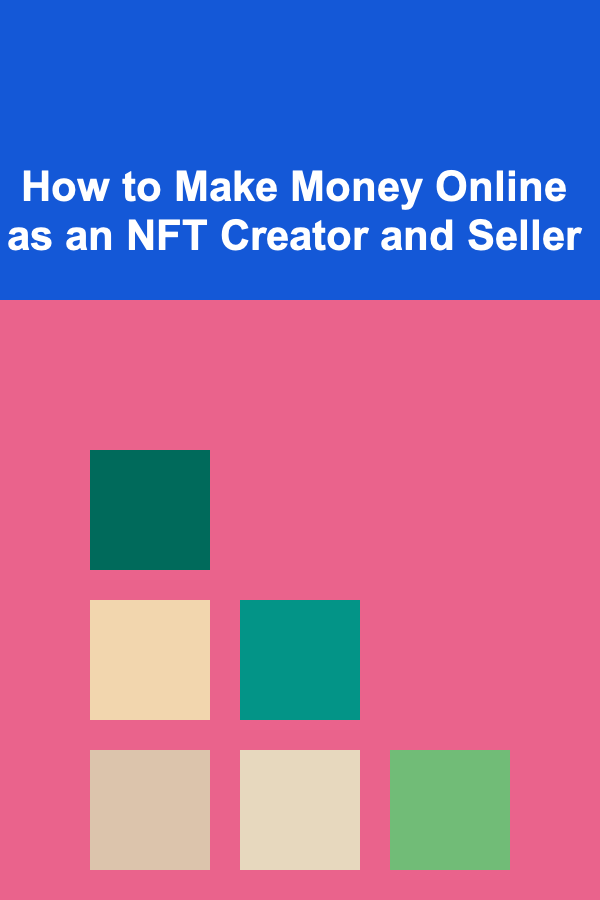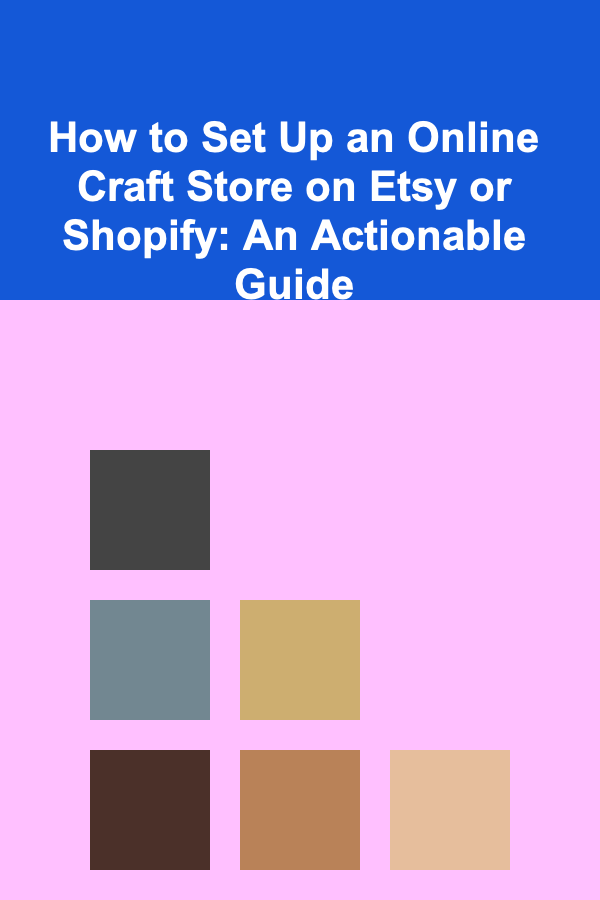
How to Make Money Online as an NFT Creator and Seller
ebook include PDF & Audio bundle (Micro Guide)
$12.99$6.99
Limited Time Offer! Order within the next:

The rise of blockchain technology has revolutionized various industries, and one of the most intriguing developments has been the rise of Non-Fungible Tokens (NFTs). As digital art, music, virtual goods, and collectibles become increasingly valuable, creators now have an exciting new avenue to monetize their work. NFTs are essentially unique digital assets that represent ownership or proof of authenticity for a piece of content, such as artwork, music, or even tweets. For artists, musicians, and content creators, NFTs present a way to engage with their audience in new and innovative ways while earning a substantial income.
In this article, we'll dive deep into how to make money online as an NFT creator and seller. From understanding the fundamentals of NFTs to the practical steps of creating, marketing, and selling them, this guide covers everything you need to know to turn your creative passion into a profitable online business.
Understanding NFTs and Their Potential
What is an NFT?
NFTs are digital assets that exist on a blockchain, which is a decentralized and secure digital ledger. Unlike cryptocurrencies such as Bitcoin or Ethereum, which are fungible (meaning each unit is interchangeable), NFTs are unique. Each NFT represents a specific piece of digital content, and ownership of that content is recorded on the blockchain. This makes NFTs ideal for verifying the authenticity and provenance of digital creations, such as art, videos, music, and other forms of media.
What makes NFTs so appealing to creators and buyers alike is their ability to assign value to a digital asset that is otherwise easily replicable. By minting an NFT, creators can ensure that their work is recognized as one-of-a-kind or part of a limited series, which adds intrinsic value to the content.
Why Should Creators Consider NFTs?
For creators, NFTs provide numerous advantages. Here are a few reasons why creators are flocking to the NFT space:
- Monetize Digital Content: NFTs allow creators to sell their digital work directly to consumers without intermediaries. This gives artists and creators the opportunity to make money from their digital creations in a way that was not possible before.
- Smart Contracts: NFTs come with the benefit of smart contracts, which can automatically execute transactions based on predefined conditions. This means that creators can include royalties in their NFTs, ensuring they receive a percentage of sales every time the NFT is resold.
- Global Market: NFTs are traded on blockchain platforms, which are global and decentralized. This means that creators can reach an international audience without the need for traditional distribution channels.
- Authenticity and Provenance: Because NFTs are tied to a blockchain, each token comes with a history that proves its authenticity and ownership. This can increase the value of the work and attract collectors who are looking for rare or exclusive items.
Getting Started as an NFT Creator
Before diving into creating and selling NFTs, it's important to familiarize yourself with the process. Here are the key steps you need to follow to get started:
1. Choose Your Niche and Medium
The first step in becoming an NFT creator is choosing your niche and deciding on the medium for your NFTs. The possibilities are virtually endless when it comes to what can be turned into an NFT:
- Digital Art: This is the most common form of NFTs, and it encompasses illustrations, paintings, 3D models, and graphic design. If you are an artist, digital art is a natural starting point.
- Music and Audio: Musicians can mint their songs or soundtracks as NFTs, giving them the opportunity to sell their music directly to their fans.
- Videos and Animations: Short films, animations, and video clips can be turned into NFTs as well.
- Collectibles: NFTs can represent collectible items, such as trading cards, virtual pets, or in-game items. These NFTs often have value because they are part of a limited edition or a series.
- Virtual Real Estate: Some platforms allow users to buy, sell, and trade virtual land in digital worlds like Decentraland or The Sandbox.
Once you decide on your niche and medium, it's time to start creating. Ensure your content is unique, high-quality, and aligned with your target audience's interests.
2. Create Your Digital Art or Content
Creating high-quality, original content is the foundation of becoming a successful NFT creator. Here are some tips to help you create content that stands out:
- Focus on Quality: While NFTs offer a new way to monetize digital content, quality still matters. Take your time to create art or media that resonates with your target audience.
- Stay Authentic: The NFT space values originality. Ensure that your work is a true representation of your creative vision.
- Experiment with Styles: Don't be afraid to experiment with different styles, mediums, and approaches to create something unique and eye-catching.
- Consider Rarity: Many NFT buyers are drawn to limited edition works or one-of-a-kind pieces. Think about how you can create scarcity or rarity in your offerings to increase their value.
3. Set Up Your Digital Wallet
In order to create, sell, and buy NFTs, you'll need a digital wallet that can store cryptocurrency (such as Ethereum) and manage NFTs. Some popular wallets that support NFTs include:
- MetaMask: A widely-used browser extension that allows you to interact with blockchain-based applications and stores your Ethereum.
- Trust Wallet: A mobile wallet that supports a wide range of cryptocurrencies, including Ethereum.
- Coinbase Wallet: An easy-to-use wallet that integrates with Coinbase and supports Ethereum-based NFTs.
When setting up your wallet, be sure to choose one that is compatible with the NFT marketplace you plan to use. Most NFTs are minted and traded on Ethereum-based platforms, but some other blockchains like Binance Smart Chain and Tezos are also gaining traction.
4. Choose an NFT Marketplace
Once your wallet is set up, the next step is choosing an NFT marketplace where you can mint (create) and sell your NFTs. Each marketplace has its own features, fees, and target audience, so it's important to do some research before committing to one. Some popular NFT marketplaces include:
- OpenSea: One of the largest and most well-known NFT marketplaces, OpenSea allows users to mint, buy, and sell a wide variety of NFTs. It supports Ethereum, Polygon, and Klaytn blockchains.
- Rarible: A decentralized marketplace that allows creators to mint and sell their NFTs. Rarible also offers a native governance token (RARI), which allows users to participate in the platform's decision-making process.
- SuperRare: A highly curated platform focused on high-quality, one-of-a-kind digital art. SuperRare is more selective about the creators it allows, but it offers a more exclusive environment.
- Foundation: Foundation is another invite-only marketplace that focuses on showcasing high-quality digital art. Creators can mint their NFTs and auction them to buyers.
5. Mint Your NFT
Minting is the process of turning your digital content into an NFT by uploading it to a blockchain. To mint an NFT, follow these steps:
- Connect Your Wallet: Link your digital wallet to the NFT marketplace.
- Upload Your Content: Choose the file you want to mint and provide relevant details such as title, description, and any additional metadata (such as royalty percentage).
- Pay Gas Fees: Depending on the blockchain, you may need to pay a "gas fee" (transaction fee) to mint the NFT. These fees vary depending on network congestion and can fluctuate significantly, especially on the Ethereum network.
- Confirm the Minting Process: Once everything is set up, confirm the transaction, and your NFT will be minted and available for sale.
Selling Your NFTs
Once your NFTs are minted, it's time to sell them. Here's how to maximize your sales potential:
1. Set a Fair Price
Pricing your NFTs can be tricky. Consider factors such as:
- Rarity: If your NFT is a one-of-a-kind piece or part of a limited edition, you may want to price it higher.
- Market Trends: Research what similar NFTs are selling for on your chosen marketplace. This will help you understand the price range and demand for similar items.
- Royalties: Don't forget to include a royalty percentage when minting your NFT. This ensures you receive a portion of the resale price if your NFT is sold in the secondary market.
2. Promote Your NFTs
Selling NFTs is not just about listing them on a marketplace. You'll need to actively promote your work to generate interest. Here are some strategies for marketing your NFTs:
- Social Media: Use platforms like Twitter, Instagram, and TikTok to share your work and engage with potential buyers. Use relevant hashtags like #NFTs, #CryptoArt, and #NFTCommunity to reach a broader audience.
- Collaborations: Collaborating with other NFT creators or influencers in the space can help increase exposure and drive sales.
- Online Communities: Engage with NFT communities on platforms like Discord and Clubhouse. Join NFT-related groups and participate in discussions to build relationships and showcase your work.
- NFT Art Shows: Some platforms host virtual art shows or auctions for NFT creators. Participating in these events can help you gain visibility and attract buyers.
3. Engage with Your Audience
Building a relationship with your audience is key to long-term success as an NFT creator. Respond to comments, ask for feedback, and keep your fans updated on your future projects. Creating a strong, engaged community will help you sell more NFTs and build a loyal following.
Conclusion
Becoming an NFT creator and seller offers a unique opportunity to monetize your digital creations in the rapidly growing world of blockchain and cryptocurrency. By understanding the fundamentals of NFTs, choosing the right platform, and actively promoting your work, you can tap into the potential of this new and exciting marketplace. As with any new venture, success in the NFT space takes time, creativity, and persistence, but with the right strategies and a bit of hustle, you can turn your passion for creating into a profitable online business.

Becoming a Successful Real Estate Broker: Best Practices for Growing Your Business
Read More
How to Review and Compare Vendor Contracts Thoroughly
Read More
How to Set Up an Online Craft Store on Etsy or Shopify: An Actionable Guide
Read More
How To Deal with Sunburn and Skin Protection Outdoors
Read More
How to Automate Your Savings
Read More
Navigating the Labyrinth: How to Deal with Difficult People Using Psychology
Read MoreOther Products

Becoming a Successful Real Estate Broker: Best Practices for Growing Your Business
Read More
How to Review and Compare Vendor Contracts Thoroughly
Read More
How to Set Up an Online Craft Store on Etsy or Shopify: An Actionable Guide
Read More
How To Deal with Sunburn and Skin Protection Outdoors
Read More
How to Automate Your Savings
Read More